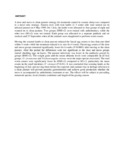Effectiveness Of Grazing Management In Controlling Gastrointestinal Nematodes In Weaner Lambs On Pasture In Denmark

View/
Date
2001-07Author
Githigia, S.M
Thamsborg, S.M
Larsen, M
Language
enMetadata
Show full item recordAbstract
dose and move to clean pasture strategy for nematode control in weaner sheep was compared to a move only strategy. Sixteen ewes with twin lambs (2–3 weeks old) were turned out on infected pasture on 4 May 1999. On 1 July, the lambs were allocated to four groups of eight and weaned on to clean pasture. Two groups (DM1+2) were treated with anthelmintics, while the other two (M1+2) were not treated. Each group was allocated to a separate paddock and set stocked until 27 September when all the animals were slaughtered to perform worm counts.
Moving the weaned lambs to clean pasture reduced the faecal egg counts to less than one third within 4 weeks while the treatment reduced it to zero for 4 weeks. Faecal egg counts of the dose and move groups remained significantly lower for 6 weeks (P<0.0001) after moving to the clean pasture. After this period the differences were not significant as the dose and move groups started shedding eggs in faeces. The pasture infectivity was lower in the paddocks grazed by groups (DM1+2). The weight gains and the serum albumin levels were comparable in all four groups. O. circumcinta and Trichostrongylus vitrinus were the major species recovered. The total worm counts were significantly lower in (DM1+2) compared to M1+2, particularly the mean counts in the small intestines (T. vitrinus) (P<0.01). It was concluded that weaning lambs at the beginning of July and moving them before the expected mid-summer rise in herbage infection to a clean pasture will prevent parasitic gastroenteritis and achieve good production whether the move is accompanied by anthelmintic treatment or not. The effects will be subject to prevailing nematode species, local climatic conditions and length of the grazing season.
URI
http://www.sciencedirect.com/science/article/pii/S0304401701004484http://hdl.handle.net/11295/73705
Citation
Githigia, S. M., Thamsborg, S. M., & Larsen, M. (2001). Effectiveness of grazing management in controlling gastrointestinal nematodes in weaner lambs on pasture in Denmark. Veterinary Parasitology, 99(1), 15-27.Publisher
University of Nairobi
